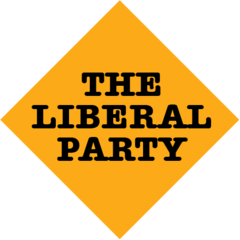Liberal Party (UK) facts for kids
Quick facts for kids
Liberal Party
|
|
|---|---|
 |
|
| Founded | 9 June 1859 |
| Dissolved | 2 March 1988 |
| Merger of | Whigs, Radicals, Peelites |
| Merged into | Liberal Democrats |
| Headquarters | Offices at the National Liberal Club, 1 Whitehall Place, London |
| Ideology | Liberalism (British) Internal factions: • Classical liberalism • Social liberalism |
| Political position | Centre |
| National affiliation | SDP–Liberal Alliance (1981–88) |
| European affiliation | Federation of European Liberal Democrats (1976–88) |
| International affiliation | Liberal International (1947–88) |
| European Parliament group | Liberal and Democratic Group (1976–85) Liberal and Democratic Reformist Group (1985–88) |
| Colours | Yellow |
The Liberal Party was an important political party in the United Kingdom. It believed in liberal ideas, which focus on individual rights and freedoms. For many years, especially in the 1800s and early 1900s, it was one of the two main political groups in the country.
The party started in the 1850s. It was a mix of different groups: the Whigs, who were an older political group, and the Peelites, who supported free trade. There were also "radicals" who wanted big changes in society.
Contents
Early Success and Leaders
Over the next 50 years, the Liberal Party formed the government four times. Their most famous leader was William Gladstone. He was Prime Minister many times and helped shape the UK.
However, the party later faced a big challenge. They disagreed about "Irish Home Rule." This was about whether Ireland should have its own government. This disagreement caused the party to split.
Return to Power and New Ideas
The Liberal Party came back to power in 1906. They won a huge number of seats in the election. During this time, they introduced important changes. These changes created the basic welfare state in Britain. A welfare state means the government helps people with things like healthcare and unemployment.
H. H. Asquith was the Liberal Prime Minister from 1908 to 1916. After him, David Lloyd George became Prime Minister until 1922. During World War I, the Liberal Party worked together with the Conservative Party. This was called a coalition government.
Decline and New Alliances
By the end of the 1920s, the Labour Party became very strong. They took the place of the Liberals as the main rival to the Conservatives. The Liberal Party started to lose power. By the 1950s, they only won a few seats in elections.
The party's luck did not change much for a long time. But in 1981, they formed an alliance with a new party called the Social Democratic Party (SDP). This alliance helped them win more votes.
In the 1983 General Election, the Alliance got more than a quarter of all votes. However, they only won 23 out of 650 seats. In the 1987 General Election, they won slightly fewer votes.
Forming the Liberal Democrats
In 1988, the Liberal Party and the Social Democratic Party decided to join together. They formed a new party called the Liberal Democrats. This new party continues to be an important political force in the UK today.
Famous Thinkers
Some very smart people were connected to the Liberal Party. These include:
- John Stuart Mill, a famous philosopher.
- John Maynard Keynes, an important economist.
- William Beveridge, who helped plan the welfare state.
Images for kids
-
Liberal politicians David Lloyd George and Winston Churchill worked on the 1909 People's Budget. This budget aimed to share wealth more fairly.
-
A crowd waiting outside Leeds Town Hall during the 1880 general elections. They wanted to see the Liberal Party candidate elected.
See also
 In Spanish: Partido Liberal (Reino Unido) para niños
In Spanish: Partido Liberal (Reino Unido) para niños







